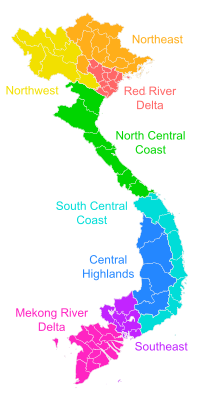Central Vietnam
You can help expand this article with text translated from the corresponding article in Vietnamese. (May 2024) Click [show] for important translation instructions.
|

Central Vietnam (Vietnamese: Trung Bộ or miền Trung), also known as Middle Vietnam or The Middle, formerly known as Trung Việt by the State of Vietnam, Trung Phần by the Republic of Vietnam,[1] Trung Kỳ or Annam under French colonial rule, is one of the three geographical regions within Vietnam.
The name Trung Bộ was used by the emperor Bảo Đại when he established administrative level higher than Province in 1945, instead of the Trung Kỳ which recalled the French occupation. This name was officially used by government of the Democratic Republic of Vietnam and is popularly used today.
The two south central costal provinces Ninh Thuận and Bình Thuận are sometimes seen as part of the Southeast region.
Administration
[edit]Central Vietnam includes 3 administrative regions, which in turn comprises 19 First Tier units.
| Administrative Region | First Tier Administrative Units | Area (km2)[2][3] | Population (2022)[2] | Population Density (people/ km2) |
Notes |
|---|---|---|---|---|---|
| North Central Coast (Bắc Trung Bộ) | 51,242.75 | 11,190,830 | 218.39 | contains the coastal provinces in the northern half of Vietnam's narrow central part. They all stretch from the coast in the east to Laos in the west. | |
| South Central Coast (Duyên hải Nam Trung Bộ) |
Bình Định |
44,605.12 | 9,470,840 | 212.33 | contains the coastal provinces in the southern half of Vietnam's central part. One province borders Laos. |
| Central Highlands (Tây Nguyên) | 54,548.31 | 6,092,420 | 111.69 | contains the mountainous provinces to the west of south-central Vietnam. There are a significant number of ethnic minorities in the region. One province is along Vietnam's border with Laos, and four border Cambodia (Kon Tum borders both Laos and Cambodia). |
^† Municipality (thành phố trực thuộc trung ương)
Of all 19 First Tier units, 1 is municipality and 18 are provinces.
Gallery
[edit]-
Hồ Dynasty citadel
Thanh Hoá -
Phong Nha - Kẻ Bàng
Quảng Bình -
Thiên Mụ Pagoda
Huế -
Marble Mountains
Da Nang -
Sitting Buddha statue
Long Sơn Pagoda
Nha Trang -
Đèo Pass
Đại Lãnh, Khánh Hòa -
Twin Tower
Quy Nhơn, Bình Định -
Hòa Lai Tower
Ninh Thuận -
Chams girls
Phan Rang -
Ngoạn Mục Pass
-
Nha Trang City
-
Chams house
-
Ede long house
-
Ede children
-
Dugout boat
of the Ede people -
Mũi Né Sand Dunes
-
Rông Bridge - Đà Nẵng City
-
Trần Phú Bridge, Nha Trang
-
Hội An - Quang Nam
-
Lý Sơn
See also
[edit]References
[edit]- ^ Royal Woodblocks of Nguyễn Dynasty – World documentary heritage (2021). "Significant collections § Fonds of the Phủ Thủ hiến Trung Việt or Office of the Governor of Trung Viet". mocban.vn. The National Archives Center No. 4 (State Records and Archives Department of Vietnam). Retrieved 30 March 2021.
- ^ a b "Area, population and population density by province". General Statistics Office of Vietnam. Retrieved 12 April 2024. – Interactive table which you can view by making your selection in three boxes: (1) Cities, provinces: Select all; (2) Year: Select 2022; (3) Items: Select all.
- ^ Phê duyệt và công bố kết quả thống kê diện tích đất đai năm 2022 [Approve and announce the results of land area statistics in 2022] (Decision 3048/QĐ-BTNMT) (in Vietnamese). Ministry of Natural Resources and Environment (Vietnam). 18 October 2023. Retrieved 12 April 2024.




















